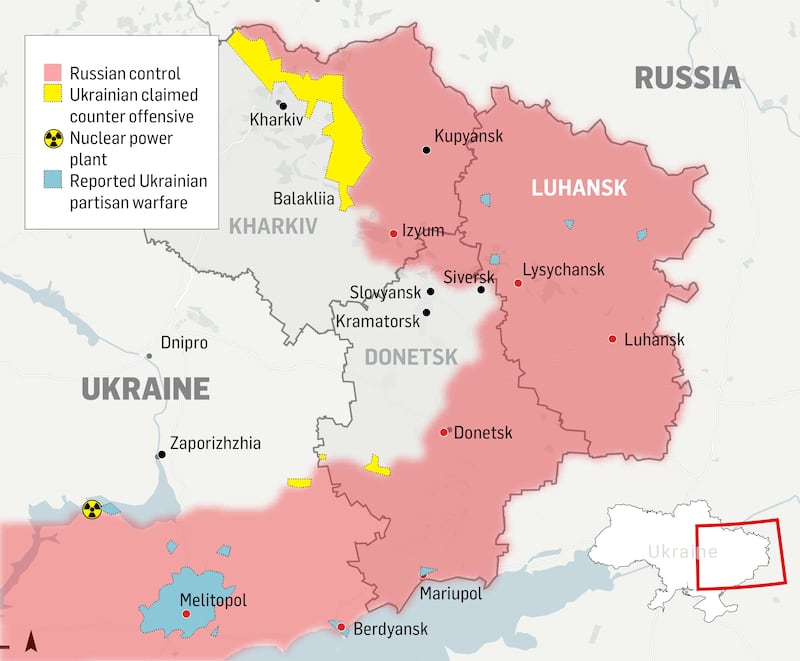Ukrainian commander Petro Kuzyk knows the secret of the offensive that has led to the collapse of Russian forces in the north-east of the country — a mixture of gritty determination, careful planning and astute use of limited western military equipment.
The result, an advance by Ukrainian troops that has liberated 3,000sq km in just six days, is Kyiv’s biggest victory since it pushed Russian troops back from the capital in March. Many Ukrainians hope the rout could mark a turning point in the nearly seven-month conflict.
“Our counter-offensive was long prepared,” said Kuzyk, a commander in the Svoboda swift reaction force of Ukraine’s national guard who took part in the attack. “We degraded their potential with constant and accurate strikes ...The general staff [also] distracted them into thinking the big counter-offensive was to come in the south.”

By the time Kuzyk and his men moved in to attack last week, the Russian forces around the south-eastern corner of Kharkiv province were already primed to panic. Many left in such a hurry that meals were still set out on canteen tables and there were crates of valuable ammunition and other weaponry stashed near the trenches.
READ MORE
“We hoped for success but didn’t expect such cowardly behaviour,” Kuzyk told the Financial Times, his voice groggy with exhaustion after six days of fighting. “They abandoned their tanks and equipment...even grabbed bicycles to escape. That the Russian army is completely degraded made our work easier; they fled like Olympic sprinters.”
[ Russian missile attacks ‘knock out power and halt water supply’ in KharkivOpens in new window ]
The Ukrainian offensive around Kharkiv has pushed Russian forces back to within 50km of the border in the north-eastern frontier, according to General Valeriy Zaluzhnyi, commander of the Ukrainian army, and follows a separate attack launched in the south, around the strategic city of Kherson.
The combined arms operation, in which Ukraine deployed a co-ordinated attack with tanks, infantry and air cover, has confounded sceptics who thought the Ukrainian army lacked sufficient troops and equipment to break what had seemed to be congealing into a military stalemate.
It has validated a deliberate strategy by Kyiv to corrode Russia’s numerical strength and vast artillery machine by using more precise western rockets and artillery strikes as well as partisan attacks to destroy key Russian ammunition dumps, logistical bases and command posts behind the front lines.
Oleksii Reznikov, the defence minister, has called it a “David versus Goliath” strategy. In the north-eastern offensive, that meant capturing the railway and logistics hubs that the Russian forces use to move the huge amounts of weaponry and fuel they need to maintain their artillery and numerical advantage over the less well-equipped Ukrainians.
“If you remove the asymmetric advantage the Russians have in artillery, they don’t only stop fighting, they flee,” said Serhiy Kuzan, a military adviser to Ukraine’s defence ministry who had just returned from the eastern front. “This was the secret to the operation. The Russian army is a blown-up balloon.”
What has surprised everyone is the speed at which the balloon seems to have deflated, at least in this section of the 1,300 km front line. At first the Ukrainians moved on Balakliia, where Kuzyk said Russian defences were “chaotically organised ... with a well-guarded first line” but second and third lines that were just “sporadic observation posts”.
When Balakliia was surrounded, the Ukrainians advanced on Kupyansk, a rail and road hub that supplies Russia’s defences across the north-east. This left vulnerable the Russian troops stationed in nearby Izyum.
“Their entire arsenal of weapons along the Izyum axis was captured,” Kuzan said. “The Russians have an advantage in weaponry, but the speed of our forces did not allow them to exploit it.”
Adding to Ukrainian momentum, the Russian defence ministry then said on Saturday it had ordered its troops to pull back from Balakliia and Izyum, claiming this would allow them to focus on a different front line. “They said it was an evacuation. But it was [a] panic retreat,” said Kuzan.
Both Kuzyk and Kuzan said Ukraine needed more weaponry to keep forcing the Russians back. “If we get that, the challenge will be to stop our forces at the border,” Kuzyk said.
The strategic effect of what this attack has already achieved — other than free vast swaths of thinly populated Ukrainian territory — are still to become clear. “The development of this campaign has been better than we expected and that means the army general staff will also be changing their plans according to the successful results,” said Reznikov.
Mark Galeotti, a veteran Kremlin watcher and military analyst, warned: “You should never completely underestimate the Russians, even if they can seem like a Keystone Cops army.
“But it [the offensive] does provide Ukraine with the military magic of momentum, which deliberately keeps the Russians guessing as to what might come next and all the different ways Russia should disperse its troops.”
What it has inarguably done is give Ukraine a massive morale boost — to its own troops and to its western partners — while severely denting Russian confidence. Ramzan Kadyrov, Chechnya’s strongman leader, is among those who are criticising Russia’s military for the retreat. He said that if the army’s strategy didn’t change, he would speak to the “leadership of the country”.
The attack has “achieved a major psychological break in the spirit of Russian soldiers — and fighting spirit is the key for ground troops, without it they have no chance,” Kuzan said. It had also knocked “the spirit of Russian society; we already see how they are seeking who to blame”. — Copyright The Financial Times Limited 2022



















